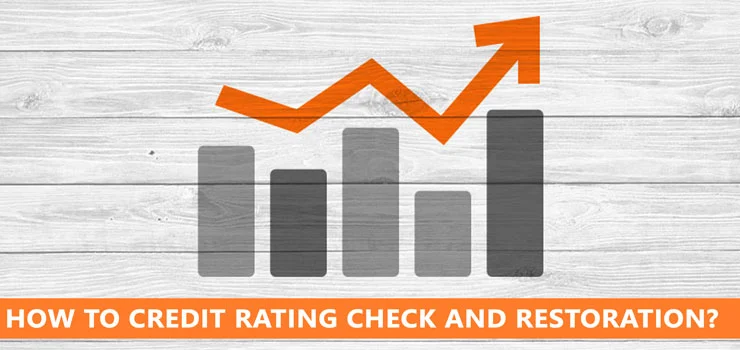-
Posted on: 24 Dec 2022

-
Understanding your credit rating is crucial for financial well-being. This guide provides a comprehensive walkthrough on how to check your credit rating and outlines effective strategies for credit rating restoration, empowering you to take control of your financial future. We cover everything from initial checks to dispute resolution and rebuilding credit.
Understanding Credit Ratings
A credit rating, often referred to as a credit score, is a numerical representation of your creditworthiness. Lenders, landlords, insurers, and even some employers use this score to assess the risk associated with lending you money or offering you services. A higher score generally indicates a lower risk, leading to better loan terms, lower interest rates, and easier approval for credit products.
In 2025, credit scores continue to be a cornerstone of personal finance. They are dynamic, meaning they can change based on your financial behavior. Understanding what constitutes a good credit score and how it's calculated is the first step towards achieving financial stability and accessing the best financial opportunities available.
The Importance of a Good Credit Score
A strong credit score is not just about getting approved for a credit card. It has far-reaching implications:
- Loan Approvals: A good score significantly increases your chances of getting approved for mortgages, auto loans, and personal loans.
- Interest Rates: The lower your credit score, the higher the interest rates you'll likely pay on borrowed money. This can cost you thousands of dollars over the life of a loan. For instance, a borrower with a score in the high 700s might qualify for a mortgage interest rate of 5.5%, while someone with a score in the low 600s might face rates of 7.5% or higher. In 2025, the difference in monthly payments can be substantial.
- Rental Applications: Many landlords check credit scores to gauge a tenant's reliability in paying rent on time.
- Insurance Premiums: In many states, insurance companies use credit-based insurance scores to set premiums for auto and homeowners insurance. A better score can lead to lower insurance costs.
- Utility Services: Some utility companies may require a security deposit if you have a low credit score.
- Employment: Certain employers, particularly those in financial or security-sensitive roles, may review credit reports as part of their background checks.
Credit Score Ranges (General Overview for 2025)
While specific score ranges can vary slightly between credit bureaus and scoring models (like FICO and VantageScore), here's a general breakdown common in 2025:
Score Range Rating Implications 800-850 Exceptional Excellent credit; qualify for the best terms and rates. 740-799 Very Good Strong credit; typically qualify for favorable rates. 670-739 Good Decent credit; generally approved for credit, but rates may be higher. 580-669 Fair Credit is often an issue; may face higher rates or require a co-signer. 300-579 Poor Significant credit challenges; difficult to obtain credit. How to Check Your Credit Rating
Knowing your credit score is the first step towards managing it effectively. Fortunately, checking your credit score is easier and more accessible than ever. In 2025, there are several reliable methods to access your credit information.
1. Annual Credit Reports from the Three Major Bureaus
Under the Fair Credit Reporting Act (FCRA), you are entitled to one free credit report from each of the three major credit bureaus (Equifax, Experian, and TransUnion) every 12 months. This is the most comprehensive way to see the data that makes up your credit score.
How to get them:
- Visit the official website: AnnualCreditReport.com. This is the only federally authorized website for obtaining your free reports.
- Request your reports online, by phone, or by mail.
- Tip for 2025: Due to ongoing accessibility, you can often get free weekly reports from each bureau through AnnualCreditReport.com until the end of 2025. Check the website for the latest updates.
What to look for:
- Personal Information: Ensure your name, address, Social Security number, and date of birth are accurate.
- Account Information: Verify all credit accounts (credit cards, loans, mortgages) are yours and that the balances, credit limits, and payment history are reported correctly.
- Inquiries: Note any recent credit inquiries. Too many hard inquiries in a short period can negatively impact your score.
- Public Records: Check for any bankruptcies, liens, or judgments.
2. Credit Monitoring Services and Apps
Many financial institutions, credit card issuers, and third-party services offer free access to your credit score, often updated monthly or even daily. These are typically "soft" inquiries and do not affect your credit score.
Examples include:
- Credit Card Companies: Many major credit card providers (e.g., Chase, Discover, American Express) offer free FICO scores to their cardholders through their online portals or mobile apps.
- Banks and Credit Unions: Your primary bank may also provide free credit score access as a customer benefit.
- Free Credit Monitoring Services: Websites like Credit Karma, Credit Sesame, and others offer free access to your VantageScore and credit reports. While these are excellent for monitoring, remember they may use VantageScore, which can differ from the FICO score most lenders use.
Pros: Convenient, frequent updates, often include credit monitoring alerts for changes to your report.
Cons: May not always provide the exact FICO score lenders use; some free services may try to upsell you on paid features.3. Paid Credit Monitoring Services
For a fee, you can subscribe to services that offer more robust features, such as daily credit score updates, comprehensive identity theft protection, and advanced monitoring across various financial accounts.
When to consider: If you've experienced identity theft, are actively working on credit restoration, or simply want the highest level of monitoring and alerts.
What Influences Your Credit Rating?
Your credit score is not arbitrary; it's calculated based on specific factors. Understanding these elements is key to both checking your score accurately and implementing effective restoration strategies. The most common scoring models, FICO and VantageScore, weigh similar factors, though the exact percentages may differ.
The Five Key Factors (FICO Model)
The FICO score model, widely used by lenders, breaks down your creditworthiness into five main categories:
1. Payment History (Approximately 35% of score)
This is the most significant factor. It reflects whether you pay your bills on time. Late payments, missed payments, defaults, collections, and bankruptcies all have a substantial negative impact.
- On-time payments: Crucial for building a good score.
- Late payments: The severity depends on how late (30, 60, 90+ days) and how recent.
- Collections: Accounts sent to collection agencies are very damaging.
- Public records: Bankruptcies, judgments, and liens have a severe, long-lasting negative effect.
2. Amounts Owed (Credit Utilization Ratio - Approximately 30% of score)
This factor looks at how much credit you're using compared to your total available credit. It's often referred to as your credit utilization ratio (CUR).
- Credit Utilization Ratio (CUR): Calculated by dividing the total balance on your revolving credit accounts by your total credit limit. For example, if you have a credit card with a $10,000 limit and a balance of $3,000, your CUR is 30%.
- Ideal CUR: Experts recommend keeping your CUR below 30%, and ideally below 10%, across all your accounts and on individual cards. High utilization signals to lenders that you might be overextended.
- Revolving Credit: This primarily applies to credit cards and lines of credit. Installment loans (like mortgages or auto loans) are considered differently, focusing more on the original loan amount and payment history.
3. Length of Credit History (Approximately 15% of score)
This factor considers how long your credit accounts have been open and how long it's been since you last used them. A longer credit history generally indicates more experience managing credit.
- Average Age of Accounts: The average age of all your open credit accounts.
- Age of Oldest Account: The age of your oldest credit account.
- Tip: Avoid closing old, unused credit cards if they have a good payment history, as this can shorten your average credit history length.
4. Credit Mix (Approximately 10% of score)
This factor assesses the variety of credit you manage. Lenders like to see that you can handle different types of credit responsibly.
- Types of Credit: This includes revolving credit (credit cards) and installment loans (mortgages, auto loans, student loans, personal loans).
- Note: While a mix is good, don't open new accounts just to diversify your credit mix if you don't need them. This factor has a relatively small impact.
5. New Credit (Approximately 10% of score)
This factor looks at how many new credit accounts you've opened recently and how many hard inquiries you've had.
- Opening New Accounts: Opening several new accounts in a short period can be seen as a sign of financial distress or increased risk.
- Hard Inquiries: Occur when a lender checks your credit for a loan or credit card application. Each hard inquiry can slightly lower your score.
- Rate Shopping: Credit scoring models usually allow a grace period (typically 14-45 days) for rate shopping for mortgages, auto loans, or student loans, where multiple inquiries for the same type of loan are treated as a single inquiry.
Common Reasons for a Low Credit Rating
Identifying the root causes of a low credit rating is essential for effective restoration. Often, it's a combination of factors that, over time, have eroded creditworthiness. In 2025, these common pitfalls continue to be the primary drivers of poor credit.
1. Late or Missed Payments
As mentioned, this is the most impactful factor. Consistently failing to pay bills by their due date signals a lack of financial responsibility to lenders. Even a single 30-day late payment can significantly lower your score, and multiple delinquencies or payments over 60 or 90 days late will have a more severe and lasting effect.
2. High Credit Utilization Ratio
Maxing out credit cards or carrying high balances relative to your credit limits is a major red flag. Lenders see this as a sign that you are heavily reliant on credit and may struggle to manage your debt. A high CUR indicates a higher risk of default.
3. Collections Accounts
When you fail to pay a debt, the creditor may eventually send the account to a collection agency. Having an account in collections is a serious negative mark on your credit report and can drastically lower your score. These can remain on your report for up to seven years.
4. Too Many Hard Inquiries
Frequently applying for new credit can make you appear desperate for funds or financially unstable. Each hard inquiry can ding your score by a few points, and multiple inquiries within a short timeframe can add up, signaling higher risk to lenders.
5. Lack of Credit History (Thin File)
Conversely, having very little or no credit history can also result in a low or unestablished credit score. Lenders need data to assess your creditworthiness, and a lack of information makes it difficult for them to approve you for credit, especially larger loans like mortgages.
6. Errors on Your Credit Report
Mistakes happen. Incorrect information on your credit report, such as accounts that aren't yours, incorrect payment statuses, or outdated negative information, can unfairly drag down your score. This is why regular checking is vital.
7. Defaults and Foreclosures
These are severe credit events. Defaulting on a loan or facing foreclosure on a property indicates a significant inability to meet financial obligations and will severely damage your credit for many years.
8. Bankruptcies
Filing for bankruptcy is one of the most damaging events for a credit score. Chapter 7 bankruptcies can remain on your report for up to 10 years, while Chapter 13 bankruptcies typically stay for 7 years. However, they often begin to have less impact over time.
9. Identity Theft
If your identity is stolen, fraudulent accounts can be opened in your name, leading to missed payments and collections that negatively impact your credit. This highlights the importance of monitoring your credit for suspicious activity.
Credit Rating Restoration Strategies
Restoring a damaged credit rating is a marathon, not a sprint. It requires patience, discipline, and a strategic approach. By focusing on the factors that influence your score, you can systematically improve your creditworthiness. Here are effective strategies for credit rating restoration in 2025.
1. Obtain and Review Your Credit Reports
As detailed earlier, start by getting your free annual credit reports from Equifax, Experian, and TransUnion. Scrutinize each report for errors and identify the specific issues negatively impacting your score (e.g., late payments, high balances, collections).
2. Dispute Inaccuracies
If you find any errors, dispute them immediately with the credit bureaus and the creditor that reported the information. This is a critical step in credit restoration. (More on this in the next section).
3. Pay Down High Credit Card Balances
Focus on reducing your credit utilization ratio. Prioritize paying down balances on credit cards with the highest utilization first (the "avalanche method") or those with the highest interest rates (the "snowball method" if you prefer quick wins, though avalanche is mathematically superior for debt reduction). Aim to get your utilization below 30%, ideally below 10%.
Example: If you have a card with a $1,000 limit and a $900 balance (90% utilization), paying it down to $300 (30% utilization) will significantly boost your score. Doing this across multiple cards will have an even greater impact.
4. Catch Up on Past-Due Accounts
If you have accounts that are currently past due, bring them current as soon as possible. The longer an account remains delinquent, the more damage it does to your score. Once current, ensure you make all future payments on time.
5. Negotiate with Creditors and Collection Agencies
If you have accounts in collections, or are struggling to make payments, contact your creditors or the collection agency. You may be able to negotiate a payment plan, a settlement for less than the full amount owed, or even have the negative mark removed from your report in exchange for payment (pay-for-delete agreement – though this is not guaranteed and requires careful negotiation).
Important Note: A settlement may still be reported as "settled for less than full amount," which is better than an unpaid collection, but still negative. Always get any agreement in writing before making a payment.
6. Avoid Opening New Unnecessary Credit
While adding new credit can eventually help your credit mix and history length, opening too many new accounts too quickly will hurt your score due to hard inquiries and a reduced average account age. Only apply for credit you genuinely need.
7. Consider a Secured Credit Card or Credit-Builder Loan
If you have a very low score or a thin credit file, these products are designed to help you build positive credit history.
- Secured Credit Card: You provide a cash deposit, which becomes your credit limit. Use it responsibly for small purchases and pay the bill in full and on time each month.
- Credit-Builder Loan: The loan amount is held in an account while you make payments. Once the loan is repaid, you receive the funds, and the positive payment history is reported to credit bureaus.
8. Set Up Payment Reminders and Auto-Pay
To prevent future late payments, utilize calendar reminders, set up automatic payments for at least the minimum amount due (though paying in full is ideal), and ensure you have sufficient funds in your account to cover these payments.
9. Be Patient and Consistent
Credit repair takes time. Negative information typically stays on your report for seven years (bankruptcies for 7-10 years), but its impact diminishes over time. Consistent, responsible financial behavior is the most effective long-term strategy.
Disputing Errors on Your Credit Report
One of the most powerful tools in credit rating restoration is the ability to dispute inaccuracies on your credit report. The FCRA grants consumers the right to a fair and accurate credit report. If you find errors, taking prompt action can significantly improve your score.
Steps to Dispute an Error
1. Identify the Error
Carefully review your credit reports from Equifax, Experian, and TransUnion. Look for:
- Accounts that do not belong to you.
- Incorrect personal information (name, address, SSN).
- Accounts listed as delinquent when they were paid on time.
- Incorrect balances or credit limits.
- Duplicate negative entries.
- Outdated negative information that should have been removed.
- Accounts listed as closed that are still open or vice versa.
2. Gather Evidence
Collect all supporting documentation for your dispute. This might include:
- Copies of your credit reports highlighting the error.
- Payment records (cancelled checks, online payment confirmations, bank statements) proving timely payments.
- Correspondence with the creditor.
- Proof of identity if personal information is incorrect.
- Letters of explanation if you've had identity theft.
3. File a Dispute with the Credit Bureau
You must file your dispute directly with the credit bureau that shows the inaccurate information. You can do this online, by mail, or by phone.
Online: This is usually the fastest method. Visit the website of the specific bureau (Equifax, Experian, TransUnion) and navigate to their dispute section.
By Mail: Send a certified letter with return receipt requested to the credit bureau's dispute department. Include your full name, address, phone number, Social Security number, and a clear description of the error and why you believe it's inaccurate. Attach copies of your supporting documents (never send originals).
What to Include in Your Letter/Online Dispute:
- Your personal information.
- The account number or item you are disputing.
- A clear explanation of why the information is inaccurate.
- The evidence you are providing.
- A request for the information to be corrected or removed.
4. The Credit Bureau's Investigation
Once you file a dispute, the credit bureau has 30 days (or 45 days if you provide additional information after the initial filing) to investigate. They will contact the furnisher of the information (the creditor or collection agency) to verify the accuracy of the disputed item. The furnisher must respond to the bureau's request with information supporting the accuracy of the item.
5. Review the Results
After the investigation, the credit bureau will send you a written response. If the dispute is successful, the inaccurate information will be corrected or removed from your report, and you will receive an updated credit report. If the dispute is denied, the bureau must provide the reason for their decision and information on how to obtain a free copy of your report.
6. Dispute Directly with the Furnisher (If Necessary)
If the credit bureau's investigation doesn't resolve the issue, or if the furnisher fails to verify the information, you can also try disputing the item directly with the creditor or collection agency that reported it. This can sometimes be more effective, especially if the furnisher made an error.
7. Consider a Consumer Protection Attorney
If you believe a credit bureau or furnisher has violated your rights under the FCRA, or if you're dealing with persistent inaccuracies, consulting with a consumer protection attorney specializing in credit reporting may be beneficial.
Building and Rebuilding Credit
Whether you're new to credit or recovering from past mistakes, building a positive credit history is achievable. The key is to demonstrate responsible credit management over time. In 2025, the principles remain the same: consistency and diligence.
Strategies for Building Credit
1. Become an Authorized User
If you have a trusted friend or family member with excellent credit, they can add you as an authorized user to one of their credit cards. Their positive payment history on that account can then appear on your credit report, helping to build your own credit history. Ensure the primary cardholder uses the card responsibly.
2. Get a Secured Credit Card
As mentioned earlier, secured credit cards are an excellent tool for building credit. Your security deposit acts as collateral, minimizing risk for the issuer. Use it for small, everyday purchases and pay the balance in full and on time each month. Most issuers report to all three credit bureaus.
3. Apply for a Credit-Builder Loan
These loans are specifically designed for individuals looking to establish or rebuild credit. The loan amount is typically held in an escrow account, and you make regular payments. Once the loan is fully repaid, you receive the funds, and your on-time payments are reported to credit bureaus.
4. Open a Store Credit Card (Use with Caution)
Store credit cards often have easier approval requirements than traditional credit cards. However, they typically come with very high interest rates and lower credit limits. If you choose this option, use it for a small purchase and pay it off immediately to build positive history without incurring high interest charges.
5. Get a Co-signer on a Loan
If you're applying for a traditional loan (e.g., auto loan, personal loan) and are struggling to get approved, a co-signer with good credit can help. The co-signer agrees to be responsible for the debt if you fail to pay. This can help you secure the loan and build positive credit history, but it also puts the co-signer's credit at risk.
Strategies for Rebuilding Credit
1. Prioritize On-Time Payments
This is non-negotiable. Make every payment on time, every time. Set up reminders, use auto-pay, and ensure you have sufficient funds. Even one late payment can set back your progress significantly.
2. Reduce Credit Utilization
Aggressively pay down balances on your credit cards. Aim for a utilization ratio below 30%, and ideally below 10%. This shows lenders you are not over-reliant on credit.
3. Avoid Closing Old Accounts
Even if you don't use them, keeping old credit accounts open (especially those with a good payment history) helps increase your average age of credit and your total available credit, both of which are beneficial for your score.
4. Be Patient with Negative Marks
Negative items like late payments and collections will eventually fall off your credit report (typically after seven years). While you work on disputing errors and building positive history, time is also a factor in their diminishing impact.
5. Monitor Your Progress Regularly
Check your credit reports and scores periodically to track your improvement and identify any new issues. This helps you stay motivated and make necessary adjustments to your strategy.
Maintaining a Healthy Credit Rating
Once you've achieved a good credit rating, the focus shifts to maintaining it. This involves consistent, responsible financial habits. The goal is to avoid the pitfalls that lead to credit damage and to leverage your good score for financial advantage.
Key Habits for Long-Term Credit Health
1. Continue Making All Payments On Time
This remains the single most important factor. Set up automatic payments for at least the minimum amount due on all your credit accounts. Schedule a calendar reminder a few days before the due date to ensure sufficient funds are available.
2. Keep Credit Utilization Low
Strive to keep your credit utilization ratio below 30% on all credit cards, and ideally below 10%. If you have a high credit limit, try to keep your balances as low as possible. Consider paying down balances before the statement closing date to ensure a lower reported utilization.
3. Avoid Excessive New Credit Applications
Only apply for new credit when you genuinely need it. Multiple applications in a short period can lower your score and signal risk to lenders. If you are rate shopping for a specific type of loan (e.g., mortgage, auto loan), do so within a concentrated period (usually 14-45 days) to minimize the impact of inquiries.
4. Review Your Credit Reports Annually
Even with good credit, it's wise to check your credit reports at least once a year from AnnualCreditReport.com. This helps you catch any potential errors or fraudulent activity early on. Consider using free credit monitoring services offered by banks or credit card companies for ongoing alerts.
5. Manage Your Credit Mix Wisely
While you don't need to open accounts solely for this purpose, having a mix of credit types (revolving credit and installment loans) can be beneficial. If you have a mortgage and an auto loan, and a few credit cards, you likely have a good mix.
6. Be Cautious with Closing Old Accounts
As long as an old credit card account doesn't have an annual fee and has a good payment history, consider keeping it open. Closing it can reduce your total available credit and shorten your average credit history length, potentially impacting your score.
7. Understand the Impact of Your Actions
Be aware that actions like co-signing for someone else's loan, making large purchases on credit without a plan to pay them off, or falling behind on payments can all negatively affect your credit score. Educate yourself on how different financial decisions impact your creditworthiness.
8. Build an Emergency Fund
Having an emergency fund can prevent you from relying on credit cards for unexpected expenses, thus helping you maintain low utilization and avoid debt. Aim to save 3-6 months of living expenses.
Conclusion: Your Path to Financial Health
Effectively checking and restoring your credit rating is a foundational element of robust financial health. By understanding the intricate workings of credit scoring, diligently reviewing your credit reports, and implementing strategic restoration techniques, you can overcome past financial challenges and build a brighter future. Remember that consistency in payment history and maintaining low credit utilization are paramount. Leverage the tools available, such as free credit reports and monitoring services, to stay informed and proactive. Your journey to a healthy credit rating is an ongoing commitment, but the rewards—better loan terms, lower interest rates, and greater financial freedom—are well worth the effort. Take control of your credit today.











